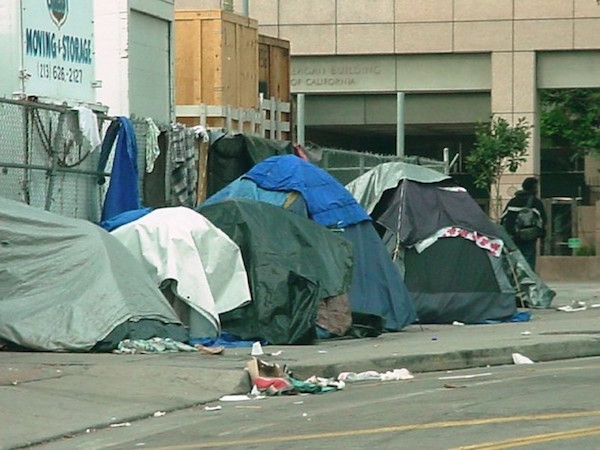Back in her disastrous welcoming heyday, Angela Merkel racked up a lot of selfie pix with new arrivals.

The figure headlined in the item below is One Trillion Euros (!), a cost which Google calculated to be an even larger number — 1,232,780,000,000.00 US Dollars. German citizens are in for a world of financial hurt for decades to come, not to mention the crime and cultural battles from all those muslims.
]]>The migrant crisis could cost the German taxpayer 1,000,000,000,000 euros, Voice of Europe, April 11, 2018
In his autobiography, “In search of the truth”, famous German economist Hans-Werner Sinn says the migrant crisis could cost the country almost one trillion euros, Focus reports. Sinn is a former advisor of Angela Merkel and retired president of the IFO Institute for Economic Research.
Germany accepted 1.5 million migrants since 2015 and Sinn says they are not dentists, lawyers and nuclear scientists, but mostly underqualified immigrants. According to him, these people can never repay what they have received from the German welfare state during their lifetimes.
While German states spent more than €20bn on refugees in 2016, it’s easy to see why Sinn’s one trillion euros estimate is a serious possibility, when looking at lifetime support for migrants. At the same time family reunifications and higher security costs are not (yet) part of the budget.
From an economic point of view, economic refugees can and must be refused, which does not mean that immigration is no longer possible, but that only those people who the EU wants to become citizens are welcome, Sinn writes in his book.
(Continues)
Still, the fact that the home of Silicon Valley and of so many tech and natural riches can be poverty stricken needs to be repeated, so perhaps people can [...]]]>
Still, the fact that the home of Silicon Valley and of so many tech and natural riches can be poverty stricken needs to be repeated, so perhaps people can grasp how stupid liberal governance is. Today’s reminder appeared in the Los Angeles Times on Sunday and is posted below.
Being a rather short item, the op-ed does leave out some vital features, in particular California’s habit of importing foreign poverty via immigration, both legal and illegal. In 2014, Governor Jerry Brown reportedly invited all of Mexico to move north, telling the Mexicans they “are welcome in California.”
Plus there are plenty of magnets for immigrants of all legalities in the state, such as drivers licenses/identification for illegal aliens, taxpayer-subsidized in-state tuition for all residents and financial aid for illegals. And as we saw recently in the trial of Kate Steinle’s killer, a criminal Mexican can get away with murder.
But back to California poverty, one painful symptom is the worsening homelessness, including some of the wealthiest cities, like San Francisco.

Homelessness is exacerbated by immigration also. It was reported in the LA Times June 18, 2017 that Los Angeles homelessness had become diverse: “Recent figures released by the county show that Latino homelessness shot up by 63% in the past year, a staggering number in a county that saw its overall homeless population soar by 23%, despite increasing efforts to get people off the street.”
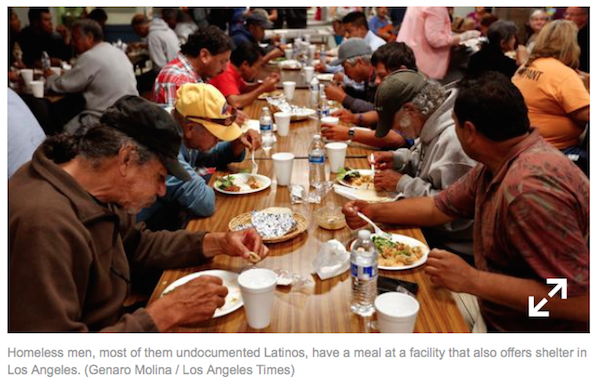
So poverty is worsened by liberal policies and has many faces.
]]>Op-Ed: Why is liberal California the poverty capital of America?, by Kerry Jackson, Los Angeles Times, January 14, 2018
Guess which state has the highest poverty rate in the country? Not Mississippi, New Mexico, or West Virginia, but California, where nearly one out of five residents is poor. That’s according to the Census Bureau’s Supplemental Poverty Measure, which factors in the cost of housing, food, utilities and clothing, and which includes noncash government assistance as a form of income.
Given robust job growth and the prosperity generated by several industries, it’s worth asking why California has fallen behind, especially when the state’s per-capita GDP increased approximately twice as much as the U.S. average over the five years ending in 2016 (12.5%, compared with 6.27%).
It’s not as though California policymakers have neglected to wage war on poverty. Sacramento and local governments have spent massive amounts in the cause. Several state and municipal benefit programs overlap with one another; in some cases, individuals with incomes 200% above the poverty line receive benefits. California state and local governments spent nearly $958 billion from 1992 through 2015 on public welfare programs, including cash-assistance payments, vendor payments and “other public welfare,” according to the Census Bureau. California, with 12% of the American population, is home today to about one in three of the nation’s welfare recipients. [. . .]
Apparently content with futile poverty policies, Sacramento lawmakers can turn their attention to what historian Victor Davis Hanson aptly describes as a fixation on “remaking the world.” The political class wants to build a costly and needless high-speed rail system; talks of secession from a United States presided over by Donald Trump; hired former attorney general Eric H. Holder Jr. to “resist” Trump’s agenda; enacted the first state-level cap-and-trade regime; established California as a “sanctuary state” for illegal immigrants; banned plastic bags, threatening the jobs of thousands of workers involved in their manufacture; and is consumed by its dedication to “California values.” All this only reinforces the rest of America’s perception of an out-of-touch Left Coast, to the disservice of millions of Californians whose values are more traditional, including many of the state’s poor residents.
(Continues)

Actually, San Francisco has struggled unsuccessfully to grapple with huge numbers of homeless camped on the street, having spent $275 million in the recent fiscal year. The success of the tech industry has attracted many workers who have pushed rents up even higher. However, the city’s extensive services may perversely exacerbate the problem by making making homelessness more survivable.
Below, a San Francisco homeless person receives box lunches delivered on Division Street.

Tucker could also have mentioned the national policy of admitting huge numbers of poor immigrants and illegal aliens who compete for the same housing as well as jobs that low-income Americans seek. Why import poor people when our own struggle to maintain even the basics of life? Homelessness is worsened by immigration, particularly in diverse communities like Los Angeles.
The Los Angeles Times reported in June that Hispanic homelessness is surging in the county, up by up by 63 percent in the past year.

]]>TUCKER CARLSON: Superficially America’s major cities are richer than ever, more and more luxury apartments going up, many of them selling to foreigners; many trendy restaurants, artisanal shops. Hip professionals love big cities. But while our cities have become a playground for the wealthy and their children, things are not looking as good for everyone else. San Francisco, New York, other cities are losing middle-class residents at a frightening clip, poverty rates remain high. Homelessness, while declining nationwide, is hitting record levels in the big cities. If you’ve been to any of them, you know — tent cities everywhere. Liberals dominate every major city: is homelessness and the disappearance of the middle class connected to their economic policies and their social policies?
As it happens, Washington’s obstinate auto-pilot immigration has imported millions of poor people who will never live without taxpayer-funded assistance for food, housing and education. The policy leaves our own poor people with the short end of the stick as schools in low-income areas are ever more crowded and dysfunctional, and American workers must compete with foreigners for jobs.
Below, a group of Obama’s border surge kids line up to get some free-to-them stuff supported by American taxes.
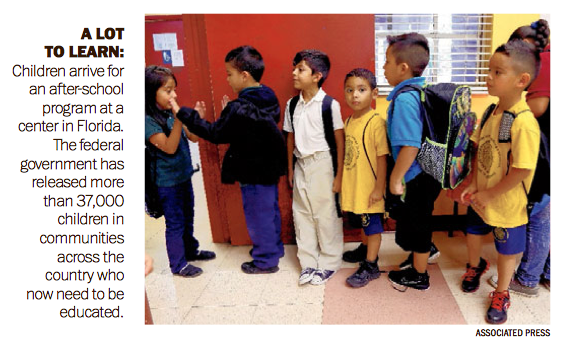
As economist George Borjas remarked the other day, mass immigration is the world’s “largest anti-poverty program” — although the influx is not kind to America’s poor and working class. “The largest loss is probably the wage drop suffered by the workers who now face more competition in the labor market,” Borjas said.
]]>Op-Ed: Why does the U.S. have such an outlier child poverty rate? Our immigration system has a lot to do with it, By Kay S. Hymowitz, Los Angeles Times, October 29, 2017
Articles about America’s high levels of child poverty are a media evergreen. Here’s a typical entry, courtesy of the New York Times’s Eduardo Porter: “The percentage of children who are poor is more than three times as high in the United States as it is in Norway or the Netherlands. America has a larger proportion of poor children than Russia.” That’s right: Russia.
Outrageous as they seem, the assertions are true — at least in the sense that they line up with official statistics. Comparisons of the sort that Porter makes, though, should be accompanied by an asterisk pointing to a very American reality. Before Europe’s recent migration crisis, the United States was the only developed country to routinely import millions of very poor, low-skilled families, from some of the most destitute places on Earth — especially from undeveloped areas of Latin America — into its communities, schools and hospitals. Let’s just say that Russia doesn’t care to do this — and, until recently, Norway and the Netherlands didn’t, either.
Pundits prefer silence on the relationship between America’s immigration system and poverty, and it’s easy to see why. The subject pushes us into the sort of wrenching trade-offs that politicians and advocates prefer to avoid. Here’s the problem in a nutshell: You can allow mass low-skilled immigration, which many consider humane. But if you do, it becomes a lot harder to pursue the equally humane goal of reducing child poverty in this country.
::
In 1964, the federal government settled on a standard definition of poverty: an annual income less than three times the amount required to feed a family (size dependent) over that period of time. Back then, close to 23% of American kids were poor. Today, about 18% of kids are below the poverty line, amounting to 13,250,000 children.
At first, immigration did not affect child-poverty figures. The 1924 Immigration Act sharply reduced the number of immigrants from poorer Eastern European and southern countries, and it altogether banned Asians. The relatively small number of immigrants settling in the United States tended to be from affluent nations. According to the Migration Policy Institute, in 1970, immigrant children were less likely to be poor than were the children of native-born Americans.
By 1980, the situation had reversed: immigrant kids were now poorer than native-born ones. Why? The 1965 Immigration and Naturalization Act overturned the 1924 restrictions and made “family preference” a cornerstone of immigration policy. In consequence of that move, as well as large-scale illegal immigration, a growing number of new Americans hailed from less-developed countries. As of 1990, immigrant kids had poverty rates 50% higher than their native counterparts. At the turn of the millennium, more than one-fifth of immigrant children were classified as poor.
Perhaps the most uncomfortable truth about these statistics is that a large majority of America’s poor immigrant children — and, at this point, a large fraction of all its poor children — are Latino.
(Continues)
Below, amnesty-seeking Dreamers paraded around [...]]]>
Below, amnesty-seeking Dreamers paraded around Hollywood in 2010 in scholarly attire to give the impression of future success.

But the narrative turns out to be false, according to a new study from the Annie E. Casey Foundation. The second generation experiences more poverty and school failure — so much for the idea of immigrant progress!
If immigrant kids are not able to succeed in American schools, perhaps the reason is that there are too many of them. School stress caused by immigrant overcrowding has been reported in many areas, resulting in deficient education for all.
]]>Children of immigrants experience more poverty, academic failure, report finds, Washington Post, October 24, 2017
Children of immigrants, who make up 28 percent of all children in Maryland and nearly a quarter of those in Virginia and the District, are more likely to live in chronic poverty and less likely to perform at grade level in school, according to a report being released Tuesday by the Annie E. Casey Foundation.
The report highlights disparities in opportunities for children of immigrants. It also highlights the harder-to-measure impacts of persistent stress on children affected by government policies that result in the profiling, deportation and detention of immigrants.
“When you hear conversations about immigration and immigration policies, it’s rare that you hear about the impacts on kids being discussed,” said Laura Speer, associate director for policy reform and advocacy for the Casey Foundation. “These kids are going to be our future leaders, our future workforce. We need them to be successful if we are going to be successful as a country.”
Nationally, there are 18 million children who live with parents who emigrated from another country. Of those, 88 percent are U.S. citizens. About 5 million children have a parent who is undocumented.
While children of immigrants make up less than a quarter of the nation’s population of children, they account for 30 percent of those from low-income families, the report says.
They are also more likely to struggle in school. Only 8 percent of fourth-graders in immigrant families scored at or above proficient in reading in 2015 compared to 38 percent of children from non-immigrant families. And just 5 percent of eighth-grade children from immigrant families scored at or above proficient in math in 2015 compared to 34 percent of children from nonimmigrant families. The report used English-language learner status as a proxy for determining which students have immigrant parents.
(Continues)
The welcome mat has been out for years for poor and sick illegals to obtain a better life with first-world benefits on the backs of the American taxpayer, and the decades’ accumulation is showing up in symptoms like diverse homelessness.
The Times’ Monday front page featured a Korean sob story that diverts from the usual success narrative that one sees in the media about that tribe. One estimate puts the number of illegal alien Koreans at 20 percent, and some of that group struggle with poverty in Koreatown and beyond. Cultural shame about any failure makes admitting illegal status a verboten subject which is interesting because hispanics essentially celebrate it.

The story is a reminder that poverty is everywhere, even tucked away in normally success-oriented communities — with excessive immigration being a big causal factor.
As usual, La Times downplays the illegal immigration aspect of the story, disguising it by saying “immigrants” may have “overstayed their visas” or “lack work permits” thereby avoiding the plain truth that some Koreans are illegal aliens and have fewer opportunities as a result. Not speaking English is rather limiting also, even in diverse LA.
]]>In booming Koreatown, these immigrants live fizzled American dreams, Los Angeles Times, June 1, 2017
When he hears his phone ring, Seon Jin Kim’s whole body flinches and his ears perk up.
A 62-year-old diabetic with diminishing eyesight, he bounds up the stairs and dives for the phone. This could be the minimum-wage job at a Koreatown pool hall he interviewed for a couple of days ago, the call that would get him back on his feet.
But it’s a wrong number. The phone rings again a few minutes later and he flies up the steps once more — another wrong number.
He couldn’t tell you where things went wrong, but after more than a decade of paint jobs, construction work and cleaning toilets, he had landed in this unofficial shelter for Koreans, run by an Episcopal priest.
For Korean immigrants in Los Angeles, Koreatown, with luxury condos, ever-crowded restaurants and a nightlife that draws the young and trendy from every part of the city, represents an ideal of prosperity and high achievement.
But decades after immigrating, few of the bus boys, cashiers, drivers, cooks and unskilled construction workers who helped build K-town embody the sort of success stories Forbes magazine once called “Bankers, Grocers and Lots of Kims.”
Often unable to speak English and lacking career skills or legal work visas, they are part of what researchers have called a “pliant, low-wage immigrant workforce,” that remains stuck in low-paying jobs nationwide.
In Koreatown, some of those workers’ stories end at a home residents call Adullam, after the Old Testament cave in which David took refuge.
There’s the man who once worked 18-hour days driving illegal cabs to support a daughter with cerebral palsy.
A mother who has worked for decades in hair salons paying off a husband’s gambling debts while raising a deaf and mute son.
A man who started one business after another, peddling clothing and perfume, until it all came crumbling down.
David left the biblical Adullam and went on to become king of Israel.
Some of the dozens of impoverished Koreans who have stayed at Koreatown’s Adullam since it opened in 2009 have moved on to jobs as supermarket cashiers or box packers. But seven have died here and others don’t see themselves leaving any other way.
The ‘enclave economy’
In 1980, a sociologist studying Cubans in Miami theorized that a self-contained economy in which Cuban-owned businesses employed other Cubans, offered a jump-start for newly arriving immigrants.
Since then, though, other researchers have found that these “enclave economies” might be more of an impediment: the ethnic clusters that are launchpads for some, can be a lifelong trap for others, leaving them vulnerable to exploitation by employers and stuck in dead-end jobs with low pay.
In Asian American enclaves, where stories of successful immigrants predominate, policymakers, social service providers and even fellow immigrants often overlook workers permanently stuck on the lower rungs, activists and academics say.
Unemployment grew nearly 200% among Asian Americans in California between 2005 and 2010, higher than for any other racial group, and in recent years Asians have become the fastest-growing segment of people in the country without legal documentation.
Anna Joo Kim, a Georgia Tech professor who has researched Koreatown, said that while social networks offer new and low-skilled immigrants opportunities they might not otherwise have, those networks often leave them trapped working in restaurants, personal services, hair salons, nail salons, massage parlors and other jobs with few prospects for advancement.
Looking beyond the success
The Rev. John Kim had been a priest at St. James Episcopal Church in Koreatown for seven years when he was startled to see a Korean man in line at the church’s weekly soup kitchen.
When he first arrived in Koreatown, he had tried to help the throngs of Latino day laborers milling about Seoul International Park.
The workers from Mexico, El Salvador and Honduras showed up every morning waiting for jobs, and he’d open the trunk of his car and hand out hot coffee, cup noodles and T-shirts with the slogan: “I’m a good worker. Jesus is a good shepherd.”
In those days, most of the Korean Americans he saw appeared wealthy; rarely had he seen anyone who appeared to be struggling.
That lone Korean man he met in 2009 said he’d ended up on the streets after his business went under; he was contemplating suicide. The shelters weren’t for him, he said — he couldn’t communicate with anyone, and felt intimidated and threatened by the drug addicts and mentally ill.
He told the priest that he was not alone; others were living tucked in the hedges behind the public library, close to the bustle of Koreatown’s office towers and restaurants.
The priest asked the man to round some up and meet him at a nearby McDonald’s. They told him that what they needed most were fast food vouchers and tokens for the bus — there was nowhere better to warm up and doze off.
The priest asked acquaintances for small donations, and began offering help. A few months later, he rented a shuttered acupuncture clinic on the outskirts of Koreatown. Since then, the “Joy Giver” shelter as the priest calls it, has relocated twice, last year to a house near the 10 Freeway.
His guests have included married couples, a U.S. army veteran, abused women, alcoholics, gambling addicts and one octogenarian with dementia.
Most had come to the United States on student or tourist visas that had long since expired.
In Koreatown, “we’re hustling amongst ourselves, we’re competing with one another,” the priest said. “Each person’s story is a novel. It’s 80 novels that have passed through here.”
Hitting bottom at a K-town sauna
Seon Jin Kim didn’t admit to himself that he needed help until he hit bottom a couple of years ago.
That bottom was the cold floor of a Koreatown sauna, where he’d been spending nights for a $15 entrance fee. One night after two months of no insulin shots, he collapsed. He woke up in a hospital three days later.
More than a decade ago, he’d fled financial troubles in Korea to start anew in Los Angeles, arriving as a tourist and then overstaying his visa. Since then, Kim had taken whatever job he could, chasing construction work in Orange County, San Jose, Las Vegas and Utah.
Broke and back in L.A., he heard about Adullam from an itinerant Korean man he met riding the bus.
The day after he awoke in the hospital, wearing nothing but his underpants, he went to see the priest, asking for help.
At Adullam, he’s learned the residents’ unspoken code: You don’t ask anyone how they ended up there. You don’t ask about children or marriages.
“You maybe learn what cigarettes they smoke,” he said.
So he has never traded life stories with Soon Choi, 65, who lives in one of several makeshift living quarters partitioned by bookcases.
Choi came to the United States in 1996 after a failed business venture in Korea, in part because he thought the United States would be better for his daughter, who was disabled with brain damage.
His first job was driving a Koreatown bandit taxi from 6 a.m. to midnight.
Living paycheck to paycheck took a toll on his marriage and he and his wife parted ways. When his vision deteriorated, he became a dispatcher. Then, his glaucoma made that impossible too.
After a few missed rent checks, his landlord evicted him. Weeks on the street became months and then years.
Choi has a son who is deployed overseas with the U.S. military, but says he couldn’t possibly tell him that his father has nowhere to live.
Not far from Soon Choi’s quarters, Yong Choi, 64, sleeps in another nook with three other residents.
He has worked as a tour guide, a security guard and a taxi driver, and has sold imported shirts, perfumes, dress shoes and belts.
He too has a son, somewhere, with whom he has lost touch. He wonders about him sometimes, he says, when he awakes in the middle of the night and lies still, so as to not disturb those sleeping nearby.
Refuge, in a garden and songs
The shelter these days is a tan-colored clapboard home with a yard — a big step up from the acupuncture clinic.
The Rev. Kim pleads with acquaintances, friends and members of his congregation to get the residents jobs at Koreatown supermarkets, liquor stores and restaurants.
He tries to keep those who don’t find work busy.
Pasted on a kitchen cabinet is a schedule of the person responsible for cleaning up each day of the week. The yard is filled with potted plants blooming with flowers of all colors that the priest encourages residents to rearrange.
On Saturdays, he brings a half-dozen of the shelter residents to St. James, where they join congregants in choir rehearsals.
None of them can read music and some just mouth the words.
But he can see it gives them pride, the priest says. And it gently reminds his regular Koreatown congregation of the invisible neighbors in their midst.

It’s the old unaccompanied minor scam of 2014 being replayed — if it ever went away in the first place.
These days, Border Patrol agents are distracted with kiddie care, time spent not doing their important job of keeping jihadists from crossing the open border.
Accompanied moppets are a ticket also, as illustrated by the illegal alien train-hoppers shown below.
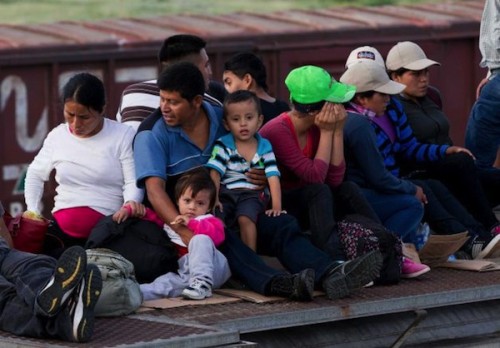
It’s helpful that Fox covered this underreported topic — though the sob-story element of the scolding nun could have been scrapped. Now, how about an update investigating the harm to American schools and students caused by so many resources being diverted to junior illegal aliens?
MELISSA FRANCIS: New security concerns concerns along the border with Mexico. Customs agents say the illegal immigration crisis is getting worse and preventing officers from doing their jobs. Casey Stegall is live in Dallas. Casey, you know this reminds me of what we saw a couple years ago, right?
CASEY STEGALL: Yeah exactly, Melissa, and this time however, the US Border Patrol tells us the problem is actually worse, and this is a fairly unreported story, but the number of unaccompanied minors and family units apprehended so far are well on track to surpass the numbers from two years ago, and Texas is the epicenter down in the Rio Grande Valley where an estimated two-thirds of those entering the country illegally passed through. For context, more than 54,000 unaccompanied minors have already been processed since August, compared to a little more than 66,000 in all of 2014. You can see where they’re going, so why the increase?
BORDER PATROL AGENT CHRIS CABRERA: You have so many people that are coming in, and they’re being released into the country and the word’s getting back to their home country, so they’re mobilizing because they they don’t know what tomorrow will bring, but they know that today they can cross.
STEGALL: And this is absolutely fascinating: when we were down at the border shooting this last week, one immigrant told me that word is spreading in Mexico and Central America to get here now because if Donald Trump wins, the word on the street down there is that the wall will go up, things will be sealed off, so the smugglers are saying to get here now, Melissa.
FRANCIS: 54,000 children — unaccompanied. I mean, is this another humanitarian crisis?
STEGALL: Absolutely, you know we’ve seen the detention centers filled with families that are packed once again just like in 2014, and the largest numbers, by the way, are people coming in from countries like El Salvador, Guatemala and Honduras, not even Mexico. Border agents say they slammed and being diverted to things like changing diapers, instead of focusing on securing the border. While volunteers like those here at the Sacred Heart Catholic Church in McAllen Texas pull together resources to help.
SISTER NORMA PIMENTEL: Look at them, see them, and tell me that you don’t feel that it is our responsibility to help them now. I wish i could be able to have everybody come and see it before they make up their mind and say that that it’s it’s not our responsibility.
STEGALL: And Border Patrol agents say most of the children and women showing up are seeking asylum, a lengthy and very long process.
]]>
How bad is the homeless problem in the City of the Angels? One measure is that businesses were concerned about “unsightly tents that block public sidewalks.” Who knew? (More photos at Daily Mail.)
According to [...]]]>
How bad is the homeless problem in the City of the Angels? One measure is that businesses were concerned about “unsightly tents that block public sidewalks.” Who knew? (More photos at Daily Mail.)
According to a May report, homelessness in the city and county increased 12 percent since 2013, largely because of unemployment, expensive housing and low wages. Those problems aren’t going away any time soon.
Los Angeles’ economic situation reflects that of the state, where the recovery has been painfully slow. California’s unemployment rate in May was 6.4 percent compared with the national rate of 5.5 percent.
Nevertheless, Democrat-run Sacramento has been busy welcoming unskilled unemployable illegal aliens with all sorts of foreigner-friendly handouts, like free-to-them healthcare for the kiddies and state ID for illegals.
Last August, Governor Jerry Brown declared to Mexico (population 125 million), “You’re all welcome in California.” This was in the middle of the continuing historic drought.
Unsolvable unemployment, not enough water for the state’s current residents, social breakdown in the largest city — so of course the solution for California Democrats is more immigration of whatever legality! Nothing is working, so let’s have more of it.
Here’s the homeless crackdown story:
]]>L.A. City Council OKs crackdowns on homeless encampments, Los Angeles Times, June 24, 2015
The Los Angeles City Council gave final approval Tuesday to an aggressive crackdown on street encampments, setting the stage for the first major homeless sweeps in the city in decades.
Mayor Eric Garcetti said he would sign the two ordinances, which authorize seizure and in some cases destruction of makeshift shelters and other property of homeless people. The mayor also said he supported proposed amendments that would drop a criminal penalty for violations and eliminate medication and personal documents from the list of belongings that can be confiscated.
Council President Herb Wesson said the council would take the amendments up soon, but he did not rule out enforcing the new ordinances before any changes go through.
“I don’t anticipate a lot of early enforcement,” Wesson said before the council meeting, which was briefly disrupted by a noisy demonstration by homeless advocates. “It is not uncommon for us to move forward then work on refining language.”
Garcetti did not say whether he supports immediate enforcement, but said through a spokesman that he backs an ordinance he believes needs fixing because existing law on homeless property is “legally untenable.”
The new laws, which will take effect as soon as they are signed and published by the city clerk, were approved in response to a four-year rise in the homeless population and an 85% increase in car camping and homeless street camps countywide. City Administrative Officer Miguel Santana, in a recent report, estimated that the city spends $100 million dealing with homelessness, more than half of it going to the police budget.
Business leaders praised the measures as a balanced approach to removing unsightly tents that block public sidewalks and alleys and pose health and safety concerns.
“We’re thankful for a new city response that’s balanced and responds to a growing public health and safety crisis,” said Raquel K. Beard, executive director of the business improvement district that covers skid row.
Opponents, including Councilman Gil Cedillo, who cast the lone no vote, said the measures would criminalize homelessness while doing nothing to help people off the streets.
“We should have a war on poverty, not on the poor,” Cedillo told the council.
“We should be building our way out of homelessness and not policing our way out,” Pete White of the Los Angeles Community Action Network said at a news conference before the meeting. Police escorted LA CAN members out of the council chambers after they staged a bit of political theater during the meeting, portraying police handcuffing and hauling off homeless people and taking their tents.
An overwhelming majority of the city’s 26,000 homeless people live in the streets. Shelter directors and housing experts say their facilities are full and there is nowhere else for homeless people to go.
The new measures — one governing streets and sidewalks, the other parks — allow authorities to take homeless people’s property on 24-hour notice even if they are present and claiming it. “Bulky” items, such as sofas and mattresses, can be confiscated and destroyed with no warning. Homeless people, under a court order, can sleep in the streets from 9 p.m. to 6 a.m., but their tents must be taken down and stored in the daytime.
Seized property will be impounded for 90 days, but the city’s only storage facility is on skid row. Advocates complain it’s a long haul for those living in other areas of the city.
The measures drew condemnation from national advocates, who said the city is running against the tide of recommended practices in the fight to end homelessness.
“It costs money to send police out after homeless people,” said Maria Foscarinis, executive director of the National Law Center on Homelessness and Poverty in Washington, D.C. “What they should be doing is taking money and putting into housing.”
The U.S. Interagency Council on Homelessness in a 2012 report endorsed 24-hour emergency access to shelter or “safe havens” as an alternative to homeless sweeps.
“Law enforcement engagement not only provides a temporary solution to the problem, it contributes to a culture of distrust, pitting individuals experiencing homelessness against the broader community,” the report said.
Criminal penalties, the report added, “actually exacerbate the problem by adding additional obstacles to overcoming homelessness.”
Attorney Peter Schey, president of the Center for Human Rights and Constitutional Law Foundation in Los Angeles, said immigrants convicted under the ordinance could be turned down for residency or citizenship. He also said the city, which has lost a long string of court decisions over its homeless enforcement practices, runs the risk of further litigation.
The council passed the new laws as urgent measures two days before the first meeting of the council’s new homelessness committee. At its meeting, committee members called for new restrooms, showers, shelters and storage facilities for homeless people, but did not identify revenue sources. The proposals were referred to staff for study.
“I don’t see how the city can acknowledge the involuntariness of the homeless, make breezy poetry about intent to provide solutions in the distant future and then feel entitled and moral to confiscate people’s property in the immediate,” said Alice Callaghan, a longtime homeless advocate and director of a skid row school for immigrants’ children.
“It’s a first step of a longer conversation on the issue of homelessness, but an important first step,” Beard, of the business improvement district, said.
The [...]]]>
The BBC recently traveled to Niger, to see the long journey of the African men north. They begin in their villages and travel to the city of Agadez, a long-time center of migrant transit where space on a truck may be bought. Then they travel 1200 miles across the perilous Sahara to the Mediterranean in hopes of reaching Europe.
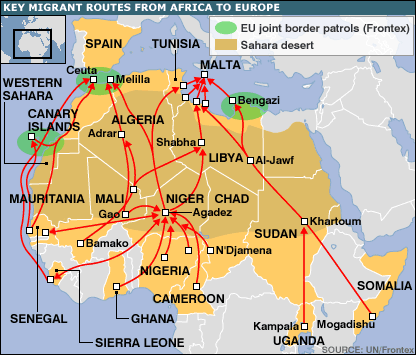
The perilous journey migrants make to reach north Africa, BBC, April 30, 2015
For migrants it is a dangerous journey to cross sub-Saharan Africa to reach the north African coast.
It is estimated that 100,000 migrants will go through the town of Agadez in Niger this year, higher than in 2014, putting their lives into the hands of smugglers. Some migrants will never make it, dying of thirst en route, or sold to militia for money.
A rugged infrastructure is in place for millions of Africans to head north, and they seem unaware of the dangers or choose to ignore them. Many of the illegal alien boat people come from Muslim nations, and the current chaos provides an enticing opportunity for jihadists wishing to make their way into infidel territory.
Europe needs to get realistic about the threat or it will be overrun in short order. The current policy of welcome is exactly the wrong message to send.
]]>